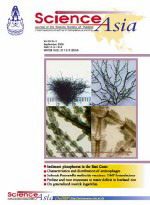ThaiScience
ThaiScience
SCIENCE ASIA
Volume 47, No. 01, Month FEBRUARY, Year 2021, Pages 40 - 46
Effect of gln151 on l-phenylalanine feedback resistance of arog isoform of dahp synthase in escherichia coli
Charintip Yenyuvadee, Nichaphat Kanoksinwuttipong, Kanoktip Packdibamrung
Abstract Download PDF
In Escherichia coli, 3-deoxy-D-arabino-heptulosonate-7-phosphate synthase (DAHP synthase) is the first enzyme in aromatic amino acid synthetic pathway. It consists of three isoforms, AroG, AroF and AroH, which are inhibited by L-phenylalanine, L-tyrosine and L-tryptophan, respectively. AroG, the major isoform, represents about 80% of the total DAHP synthase activity in the cells. To increase the production of L-phenylalanine in E. coli, it is important to reveal the inhibition mechanism of AroG and relieve the degree of inhibition. Therefore, this study aims to investigate the important amino acid residue that interacts with L-phenylalanine at the regulatory site and determine its effect on L-phenylalanine feedback inhibition. From the previously reported 3D structure of AroG co-crystallized with L-phenylalanine, Gln151 was mutated to construct L-phenylalanine feedback resistant AroG. Three mutant clones (AroGQ151A, AroGQ151L and AroGQ151N) were prepared by using QuikChange site-directed mutagenesis. The mutated enzymes exhibited a slightly higher DAHP synthase activity than the wild type, and a decrease in percentage of inhibition by 20 mM L-phenylalanine from 51% to 12–27%. The results suggested that H-bonding between Gln151 of AroG and the inhibitor, L-phenylalanine, had a high impact on L-phenylalanine feedback inhibition. aroGQ151N is the good candidate to co-express with genes encoding key enzymes in aromatic amino acid synthetic pathway to obtain the L-phenylalanine overproducing E. coli strain.
Keywords
L-phenylalanine, AroG, DAHP synthase, feedback inhibitionSCIENCE ASIA
Published by : The Science Society of Thailand
Contributions welcome at : http://www.scienceasia.org/
